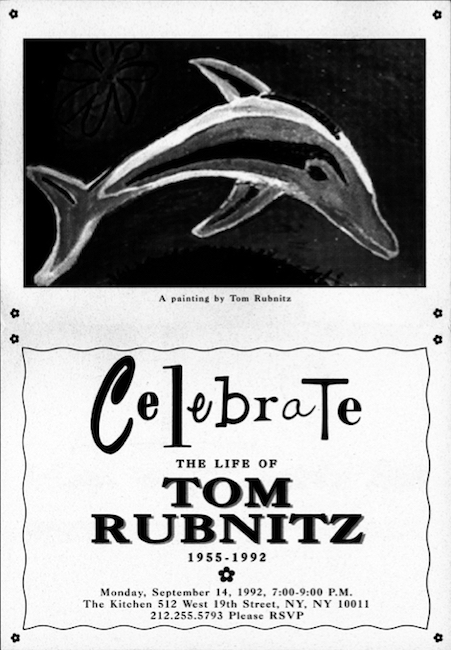Memory Palace: Lucy Sexton
November 8, 2016
TOM RUBNITZ 1955-1992
Tom’s memorial was at The Kitchen and Lady Bunny was the celebrant. There was nothing not beautiful about it: lots of performances, a showing of Tom’s films which were so fucking funny, Bunny complaining the whole time about her mascara running.
And then it happened—the moment when the earth opened up underneath us, a moment so piercing it threatened to sever us from the ground that held us. Tom’s dad got up to speak. He didn’t say much—you could tell he was a reserved man and the emotion was dangerously close to overwhelming him. He said he wanted us to know he was proud of his son. There was an involuntary sound, half gasp, half wail, from the audience. I felt Joe next to me, whose own father had threatened to kill him, levitate from his seat as he struggled not to run from the room.
The Midwestern families of other friends had either ignored their dying sons, or worse yet, tortured them with 700 Club bullshit about their certain descent into hell, but Tom’s whole family had come from Chicago to be there. And when Bunny announced that during her final song—something by Sylvester—any tips she collected would go toward preserving Tom’s video archive, Tom’s mom lined up all the nieces and nephews in their dresses and little suits giving each of them dollars to go tip Bunny with.
–Lucy Sexton
from Lost and Found: Dance, New York, HIV/AIDS, Then and Now.
Contribute to the Memory Palace
Historically, the Memory Palace is a technique of memory recall often used by ancient Greek poets. By committing a location to memory, a poet could take an imaginary “walk” through this location, thereby recalling people, faces, events, and other memorial phenomena...This is an experiment to create a conversation, to collect what can be remembered at this particular intersection in time, to see what sort of architecture might hold what is inevitably left out. It is an unfinished building. –Will Rawls
